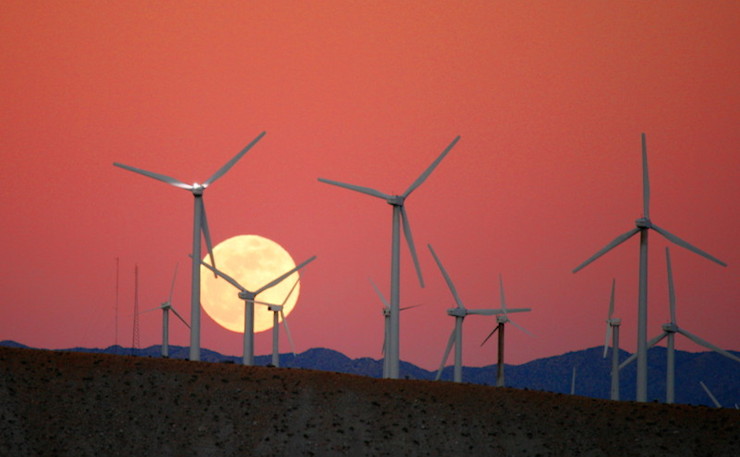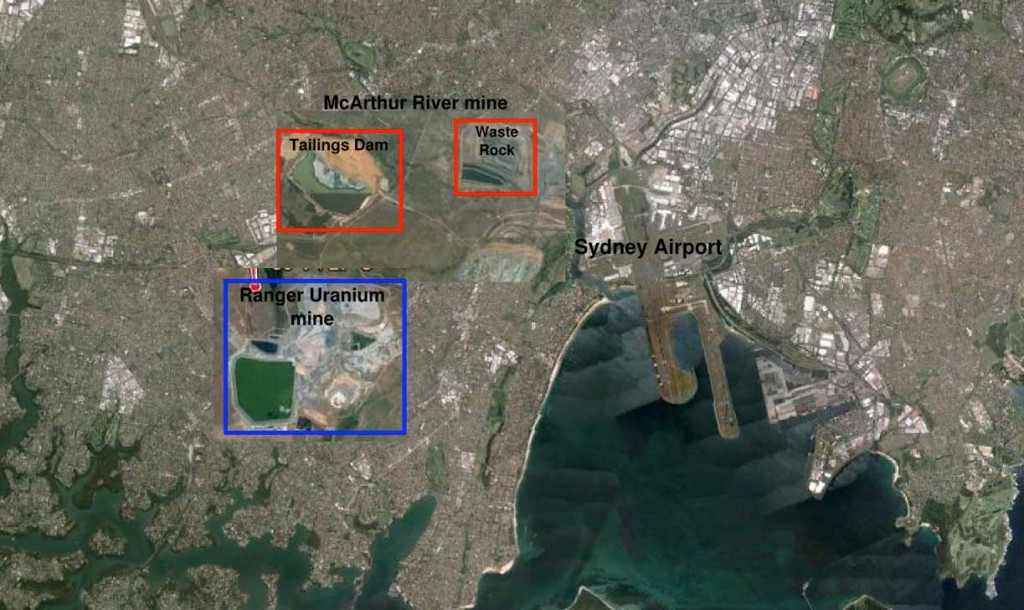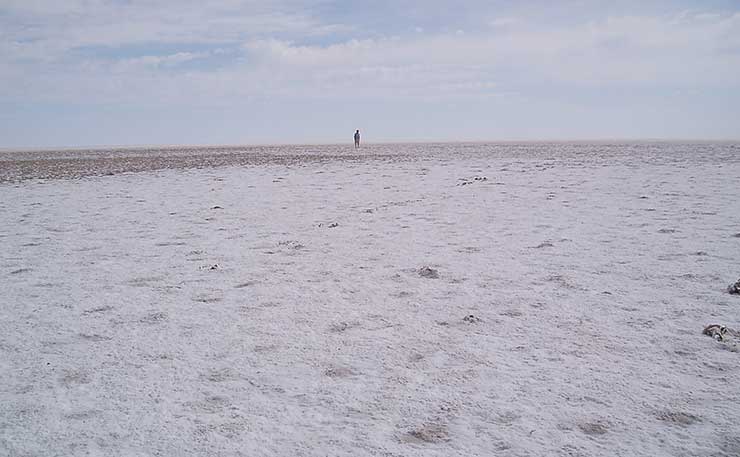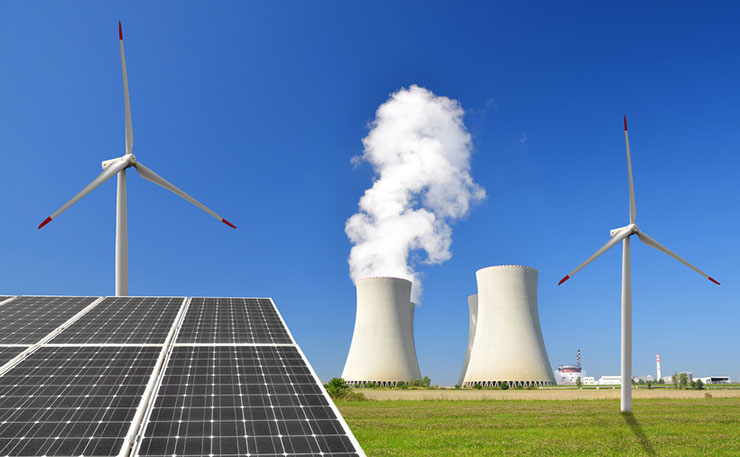Solar energy might be free, but harvesting it is very costly, both in dollar terms and on the environment, writes Geoff Russell.
I’d be guessing that large screen TVs in the pubs around Mt Isa, Broken Hill and the Northern Territory’s McArthur River mine are hard wired to show nothing but Fox Sports, but they really should have been tuned to the ABC back in November last year for Kitchen Cabinet.
They’d have been a cheerin’ and a hollerin’ over their beers as Australian Greens leader Richard Di Natale stood before the altar of his large bank of lead acid batteries and announced with messianic fervour, “This is the future!”
Sunshine may be considered a renewable energy source but the resources needed to harvest it are the same as for any other energy source; they involve land, mines, tailings dams, metals, smelting, concrete, trucks, bulldozers; the whole gamut.
But because sunshine and wind are both intermittent and unpredictable, it’s best to squirrel away what you harvest; which means more mines, smelting, tailings dams, trucks and the like.

- IMAGE: Chuck Coker, Flickr.
Focusing on the renewability of the sunshine and ignoring the harvesting infrastructure is like focusing on the oh-so-low-low price of a colour printer, while ignoring its $500-a-refill toxic toner cartridges.
Aboriginal people living around the McArthur River zinc, lead and silver mine are at the pointy end of battery production, and may not share Di Natale’s enthusiasm.
The McArthur River mine has been getting some worrying news coverage lately. Threatening disaster with fires and (claims of) tailing dam leaks, and consequently threatened with closure.
A tailings dam is where miners put all the stuff that nobody will pay them for after extracting the stuff they reckon they can sell from whatever they dig out of their bloody big holes. The extraction process generally involves water, hence the term “dam”. Typically, tailings dams contain significant amounts of material that is toxic and dangerous, forever.
As the crow flies, the McArthur River mine is about 90 km from the coast in the Northern Territory. Here it is, in two views … and in both it is just a tiny dot on the landscape at the tip of the red symbol.

Whenever people say we’ve got abundant solar resources in Australia, they’ve got an image like this in their heads. At the right scale, even huge things like the McArthur River mine look tiny. So obviously, we could cover a relatively small area of Australia in solar farms, then view it at the right scale to make it appear insignificant.
But it’s quite another thing to have something like this in your backyard.
Here’s another image of the crucial parts of the McArthur River mine; but this time it’s a much closer google earth view, superimposed at the right scale on a map of Sydney.
I’ve also added the Ranger uranium mine for reasons which will emerge later.

It’s hard to get a real sense of the size of such mines without something to compare them with. Of course, they are still small in area compared to a city like Sydney, but massive in their own right.
The actual areas of open cut for the McArthur River mine look to be roughly the same size as Ranger. I’ve cut most of them off to focus on the bits causing problems… shown in the red squares.
The left red box is the massive tailings dam, and the other is waste rock that has been spontaneously burning. The fires in this waste rock dump are the result of mistakes in the classification of the type of waste.
Rocks with rather different properties can look the same and be improperly classified, leading to mistakes in the planning and design of the dump.
The claimed problems with the tailings dams are the subject of disagreement. The company at the centre of the dispute, Glencore, acknowledges the waste rock problem and is working to fix it, but reckons there has been no leakage outside of their lease area.
The local Aboriginal people don’t trust what Glencore says about the tailings dam integrity, and NT Government Health officials aren’t convinced either.
Everybody agrees that local fish are contaminated with lead, but Glencore says it’s natural and not from any tailings leaks.
The NT Government Health official, Steven Skov, quoted by the ABC, isn’t accusing Glencore of lying, but doesn’t think their evidence is conclusive.
According to the ABC Background Briefing story I linked earlier, the Glencore claim is based on isotopic lead signatures and the Health Department would prefer before and after samples to see if mining has changed anything.
What’s an “isotopic signature”? Lead atoms can come with varying numbers of neutrons, most commonly 126, but sometimes less. Each sub-type is called an isotope and samples of lead from different sources will generally have different ratios of the types.
Given Glencore’s spontaneously burning waste rock dump, you’d certainly want a second and independent opinion on Glencore’s claims about ore lead isotope signatures, but there’s nothing intrinsically wrong with such methods.
Isotope analysis is absolutely pivotal for all kinds of science, particularly climate research, and the methods are well understood by many scientists. If you trust the technology in one scientific field, then why not in another?
Aboriginal people and others in the Northern Territory are some of the last people on the planet to use lead shot in shotguns for shooting ducks and geese. Does that result in contaminated meat? A 2012 UK study found health impacts (lowering of IQ) in children eating less than one “game bird” meal per week.

- Traditional Owners from the Borroloola Indigenous clan groups in the Northern Territory who have travelled to Glencore’s office in Sydney in March 2014. (IMAGE: Lock the Gate Alliance, Flickr)
So how do you check if the lead in a person’s blood came from lead shotgun pellets or somewhere like a leaking tailing dam or old paint? Lead isotope ratios.
If you are worried about contaminated fish, then you should also be worried about contaminated ducks and geese.
Leaking tailing dams are something that miners everywhere dread, but it’s important to do the science right and work out exactly where this lead is coming from, because blaming the wrong source means the problem won’t get fixed.
It’s entirely plausible that people have been eating lead contaminated fish for thousands of years and the only way to avoid the problem is to stop eating the fish. But being plausible isn’t the same as being true, and only independent data will settle the question. The Aboriginal people have a right to such data.
But let’s get back to the mine itself. Who the hell needs zinc, lead and silver anyway?
Zinc mines have always been important because zinc is incredibly widely used. About half of the world’s zinc is used in galvanising iron, but the rest is used in everything from brass to electrical solder to vitamin pills.
Zinc mines are particularly hot property at the moment because of interest in bloody big batteries to spackle over the gaping holes in energy output from solar panels and wind farms.
There is a major battle between zinc and lithium technologies, and if zinc were to win that battle, then we’d need more mines like McArthur River, Mt Isa and Broken Hill.
Zinc currently has an edge because it’s cheaper… partly because its many uses have driven the construction of big mines… like McArthur River.
Will zinc stay cheap? Probably not, it’s on the American Chemical Society’s (ACS) endangered chemical list. But the thing about lithium batteries is that the ones being touted for cars and home backup systems have (by weight) eight times more cobalt than lithium. And the thing about cobalt is that the biggest producer on the planet is the Democratic Republic of Congo, which produces fully 50 percent of current world production.
Here’s a picture of some children mining cobalt in DR Congo for the green big battery future. Amnesty International released a report on these horrors back in January this year.

After zinc, lead is the second major product of the McArthur River mine. Globally we use about 10.6 million tonnes of lead annually, with about 5 million coming from mines and the rest coming from recycling.
It’s used in everything from paints to shotgun pellets, but about 85 percent of global lead production is used in batteries; like those used in Richard Di Natale’s battery room.
While zinc and lithium are fighting for the high-end market with superior energy density, lead will always be a winner in the battery wars because it is cheaper than both. But if you want a serious battery backup system, then you typically need a spare room for what ends up as a really large battery set.
Imagine if all the households on the planet who have a car also emulated Di Natale’s PV system with battery backup. Instead of one standard car battery, each household would have a dozen batteries of more than double the size.
Can enough lead deposits be found and developed to meet such a rise in demand? Lead isn’t on the ACS endangered list but it is listed as “Limited Availability… Future risk to supply”. The same is true of cobalt and nickel, the other key battery components.
So a large expansion of lead or any other battery technology may not be trivial. But even assuming you can find and extract more lead, building clean smelting and recycling processes is challenging. Even rich countries like Australia have persisted with poor processes resulting in children at Port Pirie in South Australia having elevated blood lead levels for decades.
And even if the proposed Nyrstar redevelopment at Port Pirie finally results in cleaner processes, lead is still smelted and processed in filthy conditions and poisoning children in many countries; one study estimated that 15 percent of Mexican children have lost 5 IQ points due to lead poisoning.
So while the Greens are worried about nuclear waste – which has never hurt anybody – their leader spruiks an industry of monumental toxicity.
The global nuclear industry has been looking after its waste safely for decades. Not so the lead industry, and lead doesn’t have a half life… it’s toxic forever.
Which brings us back to that image of the Ranger uranium mine on that map of Sydney.

- The Ranger uranium mine, in the World Heritage Listed Kakadu National Park. (IMAGE: IAEA Imagebank, Flickr)
Mining isn’t something anybody should undertake lightly. You want to maximise the social value while minimising the area you trash in the process. So let’s run some Ranger numbers.
How much electricity has been generated during the last decade from Ranger’s uranium?
It takes about 280 tonnes of uranium to power a South Korean APR1400 reactor. So Ranger’s output over the past decade could supply about 13.45 of these reactors annually.
How much electricity would that supply? About 148 terawatt hours annually; which is about 60 percent of Australia’s total electricity demand.
Add in the Olympic Dam uranium, and we could easily power Australia from these two mines if we had the reactors.
Let’s compare this to a solar and battery alternative. Australia’s largest solar farm is at Nyngan. It covers 250 hectares and generates 230 gigawatt hours per year.
These 13.45 APR1400s would generate as much electricity annually as 637 Nyngans, covering 159,250 hectares… without needing any batteries. This is like 81,000 Melbourne Cricket Grounds.
Join them end-to-end and you have a 41-lane highway stretching from Sydney to Perth … and back to Sydney … and back to Perth and then some.
But what if we didn’t use lead, zinc or lithium to store the electricity from all those Nyngans? How about molten salt storage?
Plenty of people talk about molten salt storage, but when the public hear about it, almost everybody imagines scraping a little off the top of Lake Eyre and putting it in a few trucks. Not quite.
The salt used is a mix of sodium and potassium nitrate, produced in chemical plants using stuff that is first mined and then transformed.
Nonetheless, this kind of salt storage is well understood, but only ever been used in small powerplants.
Why? It’s easy to calculate the amount of salt needed to provide 12 hours of storage for 637 Nyngans; it comes to about 22 million tonnes.

- The salt plains of Lake Eyre, in South Australia.
The current global production of potassium nitrate is about 1.4 million tonnes, and that of sodium nitrate is similar.
So first find sites for a very large number of chemical factories, do an EIS for each one, survive local objections, or better still, build them in some developing country with more friendly tax laws and lower environmental standards, then make your 22 million tonnes and deliver them to where you want them in half a million B-double truck loads.
Like I said, sunshine might be free, but harvesting it is a bugger and storing it is even worse.
The environmental costs of a Ranger sized uranium mine are certainly significant, but tiny compared to the solar + battery alternative. And it just keeps getting better the more you understand about nuclear reactor technology.
The Chinese expect their ‘fast reactors’ to dominate the market in about 15 years time. With these reactors, you can multiply the electricity generated with a tonne of uranium by a factor of about 100. Which is exactly what the Chinese need, because they don’t have much uranium.
So what’s on the horizon for solar and batteries? Exactly the same snail pace development with tiny incremental improvements of an already resource hungry technology.
It’s all about free printers and toxic toner.
Donate To New Matilda
New Matilda is a small, independent media outlet. We survive through reader contributions, and never losing a lawsuit. If you got something from this article, giving something back helps us to continue speaking truth to power. Every little bit counts.





